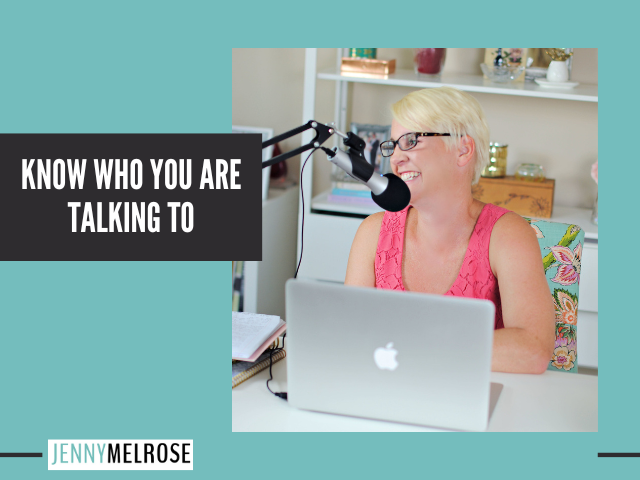Creating content consistently is great, but if you don’t know who your talking to it is likely that you are not attracting a raving audience.
Today we’re going to break down exactly how to know who you are talking to.
IE 324: Know Who You are Talking to

We are in the thick of 2023 and moving on into February.
I am continuing our series that we have been talking about that goes along with my book, Influencer Entrepreneurs: The4 Step Framework for Building Your Audience, Growing Your Business, and Making Money Online.
If you haven’t already grabbed the free workbook that goes along with it, please make sure that you do.
I really want to make sure you know who you are talking to.
This is one of the most important things that you need to understand so that you know the problem that you are solving.
When I hosted IEA summit in the beginning of January, I talked about there were three things we were focusing on.
- We were focusing on SEO.
- We were making sure that we understood the importance of growing an email list and how to actually engage with it.
- And then the third, was to know the problem you were solving for your audience.
In order to know that problem, you have to know your person, your avatar.
If you have not created a blog avatar yet, I would highly recommend checking out the episode What is an Avatar & How to Create One.
Hurdles of Knowing Who You are Talking to
One of the largest hurdles I see clients struggle with is knowing who they’re talking to.
I’m sure you’re wondering how this has anything to do with authenticity.
We often want to include everyone.
We don’t want to leave anyone out because we think, what if they could be a potential client?
So instead of making our messaging clear, we put inauthentic messages where we’re trying to reach the masses.
We create a vague message that doesn’t come across as authentic because we’re not connecting with anyone.
For example, I have a client who has a successful in-person health coaching business.
She created a food blog to compliment the coaching business and to provide her clients with recipes that fit into the recommendations she makes for their healthy life.
She takes traditional recipes and makes them healthier by making them dairy free.
She has been trying to attract everyone and doesn’t want niche down or state that the recipes were all dairy free.
She isn’t maliciously being inauthentic, but when you try to cast a wide net, you’ll never get true raving fans that will rely on you.
My recommendation is that she state that she creates dairy-free recipes to help women stay healthy in their busy lives.
That way people know exactly what to expect, and the woman looking for dairy-free recipes are likely to become her raving fans.
It’s okay to repel some people and attract others.
You are not meant to serve every single person on this earth.
Don’t roll your eyes.
I’m obviously exaggerating a bit here, but in all honesty, don’t be afraid to talk to who you are meant to talk to.
An Example of Knowing Who You are Talking to
If I offered interior design services where my expertise was modern design with clean lines and lots of white, then I shouldn’t be targeting or creating content for moms with toddlers.
For example, that modern interior designer wouldn’t want to go and share about how the metal bar stool with no back is the perfect width for a high chair, even though it is five feet off the ground and will only be attached to a four by four piece of metal.
Some of you might be hesitating and thinking I have that crazy sister-in-law that has all white furniture, tons of breakable, modern decor out, and she has a toddler.
Yep, I get it.
Seriously my sister-in-law is literally that person and how she does it and keeps her sanity, I have no idea.
Here’s the thing though.
She’s a rarity, an outlier.
As an interior designer, you should create content for an audience with older children or even no children at all.
Your content should be about how those metal bar stools are perfect for a dinner party, because you can fit six along the high top section of the counter rather than just three, because the seats are four by four in size.
It’s likely that my sister-in-law could still find you, but you do not want to target her by speaking to busy moms with toddlers.
Through this part on authenticity, we’ve talked about how important it is to give our audience an opportunity to decide if they know, like, and trust us.
In part one, we shared about our positioning and how it provides us with stories to connect with our audience.
By taking what we’ve learned so far, we should understand that our stories give our audience the opportunity to connect.
We often think that everyone could potentially like our product or service, but we have to know who we are talking to and be okay with attracting a smaller audience.
This is especially true in the beginning.
As you grow and potentially hire a team of people, you might hire someone who understands the other demographic that you’re trying to reach.
So let’s head back to our modern interior designer for a second.
The potential audience is people without toddlers, so you’re either targeting an older demographic whose children are grown, or a younger demographic who doesn’t have children quite yet.
In the example I gave above, the designer was older, so it is likely that she would look to attract a similar demographic.
Her content on Instagram would be about dinner parties and styling of her kid free home.
If she tried to show ways in which her home could be styled if she had a toddler there’d be a lot of eye rolling from the moms with kids, and the audience without kids would wonder why she’s not speaking to them.
Just think about how you feel when your mother-in-law offers you a suggestion about how to raise your kids.
It’s likely you feel like times have changed and the suggestions she’s giving may have worked 30 years ago, but they don’t work now.
Just remember that in order for your content and messaging to come across as a authentic, you want to speak to your specific audience.
Not everyone.
So in order to help you do this, one of the exercises in the free workbook is going to walk you through how to make sure that you create this, but it’s about creating a blog avatar.
You have to know who it is that you’re trying to speak to.
You can’t simply expect to be able to say to me, “Jenny, I don’t solve a problem for my audience. I just inspire. I just create recipes that attract them, or I just do DIY or decor.”
You have to go below the surface level of inspiring. In order to do that, you have to know who you’re speaking to.
Action Steps:
- If you liked this episode of Influencer Entrepreneurs, please subscribe and leave a fabulous review!
- Join the conversation on Instagram by tagging Jenny when you’re listening to the podcast. She’ll send you a personal message whenever you tag her.



